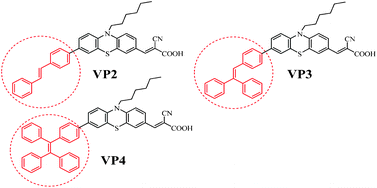Effect of polyphenyl-substituted ethylene end-capped groups in metal-free organic dyes on performance of dye-sensitized solar cells†
Abstract
A novel series of highly similar and comparable metal-free organic

* Corresponding authors
a
PCFM Lab, DSAPM Lab, MOE Key Laboratory of Bioinorganic and Synthetic Chemistry, KLGHEI of Environment and Energy Chemistry, State Key Laboratory of Optoelectronic Materials and Technologies, School of Chemistry and Chemical Engineering, Sun Yat-sen University, Guangzhou, P. R. China
E-mail:
chizhg@mail.sysu.edu.cn, kuangdb@mail.sysu.edu.cn
Fax: +86 20 84112222
Tel: +86 20 84112712
A novel series of highly similar and comparable metal-free organic

 Please wait while we load your content...
Something went wrong. Try again?
Please wait while we load your content...
Something went wrong. Try again?
C. Chen, J. Liao, Z. Chi, B. Xu, X. Zhang, D. Kuang, Y. Zhang, S. Liu and J. Xu, RSC Adv., 2012, 2, 7788 DOI: 10.1039/C2RA20819A
To request permission to reproduce material from this article, please go to the Copyright Clearance Center request page.
If you are an author contributing to an RSC publication, you do not need to request permission provided correct acknowledgement is given.
If you are the author of this article, you do not need to request permission to reproduce figures and diagrams provided correct acknowledgement is given. If you want to reproduce the whole article in a third-party publication (excluding your thesis/dissertation for which permission is not required) please go to the Copyright Clearance Center request page.
Read more about how to correctly acknowledge RSC content.
 Fetching data from CrossRef.
Fetching data from CrossRef.
This may take some time to load.
Loading related content
